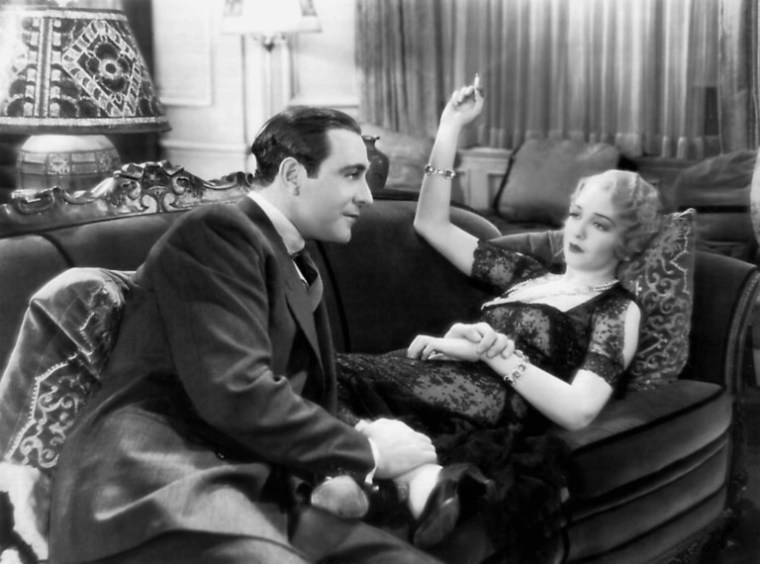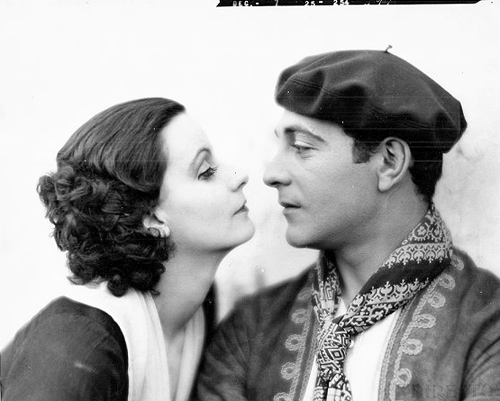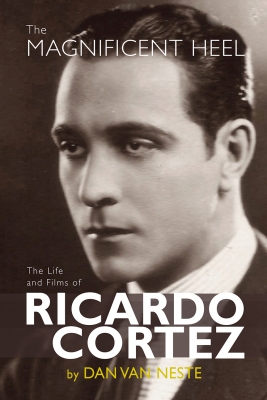
Ricardo Cortez with Bebe Daniels in The Maltese Falcon (1931). Image: Virtual Jerusalem
You know you’re in for a treat when a book begins with a definition of the word heel: “A contemptibly dishonorable or irresponsible person.”¹
A “heel” is the type of character perfected by Hollywood actor Ricardo Cortez (1900-1977), for which he received critical acclaim. Example: “Mr Cortez is one of the screen’s best menaces”². Or: “Ricardo Cortez is what is known in American parlance as a first-class rat.”³
He specialized in playing The Man You Love To Hate.
So why haven’t most people heard about him? And why are we talking about him today?
We’re glad you asked. We just finished reading The Magnificent Heel: The Life and Films of Ricardo Cortez, by historian and biographer Dan Van Neste. Van Neste has written the definitive biography of a hard-working actor who coulda been a contender.
Cortez began his Hollywood career in 1922 when Paramount Pictures hired him as a big screen Latin Lover type. He was to be a potential “replacement” in case screen legend Rudolph Valentino abandoned Paramount for another studio.
Cortez certainly had The Look. He was dark, handsome and flawlessly attired. What more could a person want in a Latino Romeo?
Except he wasn’t Latino. “Ricardo Cortez” was a creation of the studio’s publicity department. His real name was Jacob Krantz, and he was from a poor Jewish family in New York City.

Cortez with Greta Garbo. Neither were Latino. Image: Ábrete Libro
Van Neste has written an engaging, meticulously annotated history of Cortez, the man who referred to himself as a “synthetic Spaniard” (The Magnificent Heel, p. 159). Van Neste has pieced together every recoverable shred of biographical information, including an ad that claimed “Ricardo Cortez had been killed more times in the movies than any other major actor” (ibid, p. 200).
Compiling this book took four years. Van Neste had a time of it because Cortez was a notoriously private person. He didn’t keep a diary or give many interviews, and most of his contemporaries had already died. But Van Neste persisted; he had a good story about an ambitious man who tried to be a Hollywood Leading Man, but never made it.
Superstardom continually eluded Cortez, even after several busy years in the industry. According to Van Neste, the actor appeared in over 100 feature-length movies, most of which saw him playing the cad.
Cortez eventually made his peace with playing the villain instead of the Hero. “There’s always more color, more magnetism, more fascination in the villain’s role, if it is properly written, than in the hero’s,” he said (ibid, p. 169).
Critics loved his performances, and one reviewer dubbed him “the cinema’s magnificent heel” (ibid, p. 181).
Cortez himself must have been a polarizing character. He had two tumultuous marriages: the first to the troubled Alma Rubens, which ended with her death in 1931; the second to Christine Coniff Lee, which ended in divorce in 1940. Yet, his marriage to Margarette Belle – his third – lasted until his own death in 1977.
He also had uneven track record with Hollywood filmmakers. Irene Dunne adored him; Glenn Ford hated his guts.
The Magnificent Heel avoids trite conclusions about Cortez. Its primary focus is to document an actor’s life, and it does so in a highly readable manner. We could hardly put it down.
At first glance, the book is divided into two parts. The first covers Cortez’s life and career; the second is an impressive filmography complete with reviews and production notes. (If you want to learn more about the business side of the Studio Era, you’ll want to read this book for Part II alone.)
You could say the book has a third section, where Van Neste outlines his own thoughts on Cortez. It’s a thoughtful interlude, one that puts the actor’s career in context. Van Neste isn’t telling us what to think about Cortez; as biographer, he’s summing up his personal observations of a complex man.
Now, we must warn you about The Magnificent Heel. It’ll tempt you to Drop Everything so you can spend the day watching Ricardo Cortez films on YouTube.
Ask us how we know this.

Notes:
- You can order a copy of The Magnificent Heel: The Films of Ricardo Cortez by Dan Van Neste HERE.
- Check out author Dan Van Neste’s website HERE.
- Thanks to Bear Manor Media for sending us an electronic copy of this book.
¹Webster’s Collegiate Dictionary
²Los Angeles Evening Express on Cortez’s performance in Bad Company (1931)
³Los Angeles Examiner on Cortez’s performance in Flesh (1932)













I recently re-watched “The Phantom of Crestwood,” the Cortez movie I know best. I always enjoy his criminal-turned-detective performance here. He’s not a rat, but he’s willing to break rules to get to the truth, and he has no respect for the “pillars of society” he find himself among.
LikeLiked by 2 people
Ooh – that’s one I’d like to see. Author Dan Van Neste talks about that one in his book on Cortez.
LikeLiked by 1 person
I used to be somewhat critical of it: it suffers a bit from the kind of static, stagey-ness of early sound film. But, I’ve come to appreciate the performances and the atmosphere over time.
LikeLiked by 1 person
H’m, have you been spending all your time on YouTube? Can’t blame you. Dan’s book is engrossing and interesting and he truly does make you want to fill your hours with Cortez films.
LikeLiked by 2 people
I confess I’ve been spending a LOT more time on YouTube, analyzing Ricardo Cortez. I agree with you re: Dan Van Neste’s book. It truly is engrossing.
LikeLike
Nice guys finish la, especially if they are competing against a bad=boy rogue like Ricardo. This was one sexy man. I was won over with “Midnight Mary” and have never been disappointed since.
LikeLiked by 2 people
“Midnight Mary” is one I’ve yet to see, but I’ll be checking it out quickly, thanks to your enthusiastic recommendation. 😉
LikeLike
Wow – Cortez is one of those names that I’ve come across plenty of times, but even with the amount of early Hollywood research I do (admittedly focussed mostly on female filmmakers) I know horribly little about him! Will definitely add this book to the old wish list…!
LikeLiked by 2 people
It’s a well-researched book, as far as I can tell. I really liked Part 2 with all the production notes. It would be interesting to hear your thoughts on it. 🙂
LikeLiked by 1 person
Brilliant! It’s definitely on the to read list, will report back 😉
LikeLiked by 1 person
Very interesting post since I’ve only seen a handful of Ricardo Cortez films and knew nothing about him off-screen.
LikeLiked by 2 people
I knew next to nothing about Ricardo Cortez before reading the book. Certainly a complex individual.
I highly recommend this book, especially for the second part with the list of films and production notes. I thought I would just skim though this part, but I found it just as interesting as the biography – if not more interesting.
LikeLike
This sounds amazing. you’ve got me hooked.
LikeLiked by 2 people
I hope you get the chance to read it. Really is a fascinating account of classic Hollywood.
LikeLike
Youtube is so enticing, isn’t it! One of the greatest creations of the century. I have a theory that it is like our modern version of vaudeville – you can watch almost any variety act or film on it. Or even the news!
The book sounds extremely interesting. I would never have thought to want to read a book about Ricardo Cortez and yet it seems it would have been a great pity to miss it. Thanks!
LikeLiked by 2 people
I agree with you about YouTube. How can a person live without it? Love your comparison to vaudeville – never thought of it that way before.
This book on Ricardo Cortez is full of information on the studio end of Hollywood, especially Part II. I hope you’ll get the chance to read it…if you’re not busy re-reading War and Peace, that is. 😉
LikeLiked by 1 person
I did get a new translation of War and Peace! 🙂 But I admit it will probably take me years to ever read it.
Sometimes, it seems like biographies can be so focused on the person they are writing about that they don’t give a lot of context about the time or place the person lived in, but that sounds great how one can learn about the studio system, too. I’ll definitely have to look for it!
LikeLiked by 1 person
Well this sounds like a fantastic book. The author had his work cut out for him, it seems. I love the word “heel” in this context. 😀 And I love the quote: “There’s always more color, more magnetism, more fascination in the villain’s role, if it is properly written, than in the hero’s…” So true.
LikeLiked by 2 people
Yup, the author really did have his work cut out for him, but he did an amazing job. Really, this book is a study in research. It’s an interesting biography, and a great movie history resource.
LikeLiked by 1 person
this book is now on my list. I am definitely going to read this. Thanks for sharing.
LikeLiked by 1 person
I hope you get the chance to read it. It’s a terrific look at old Hollywood.
LikeLike